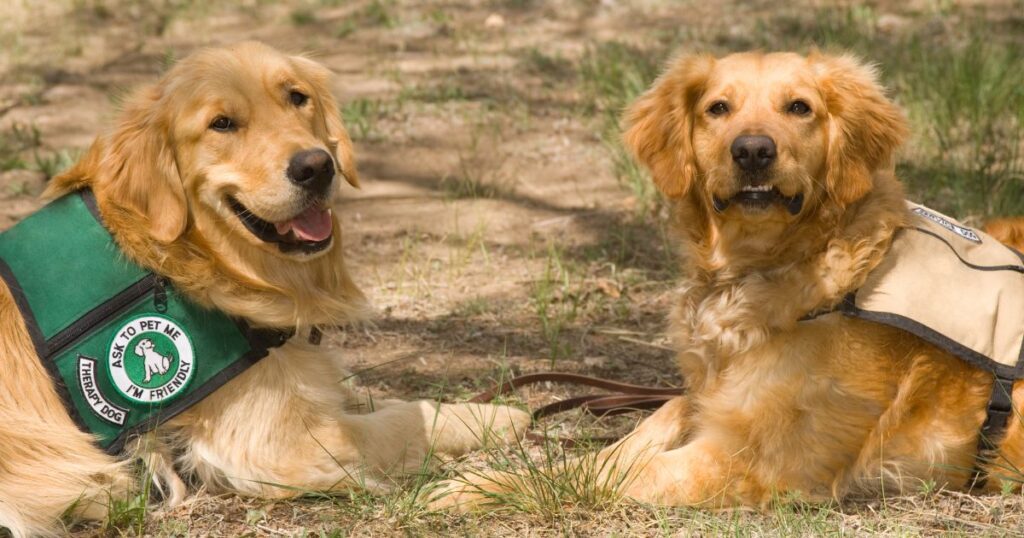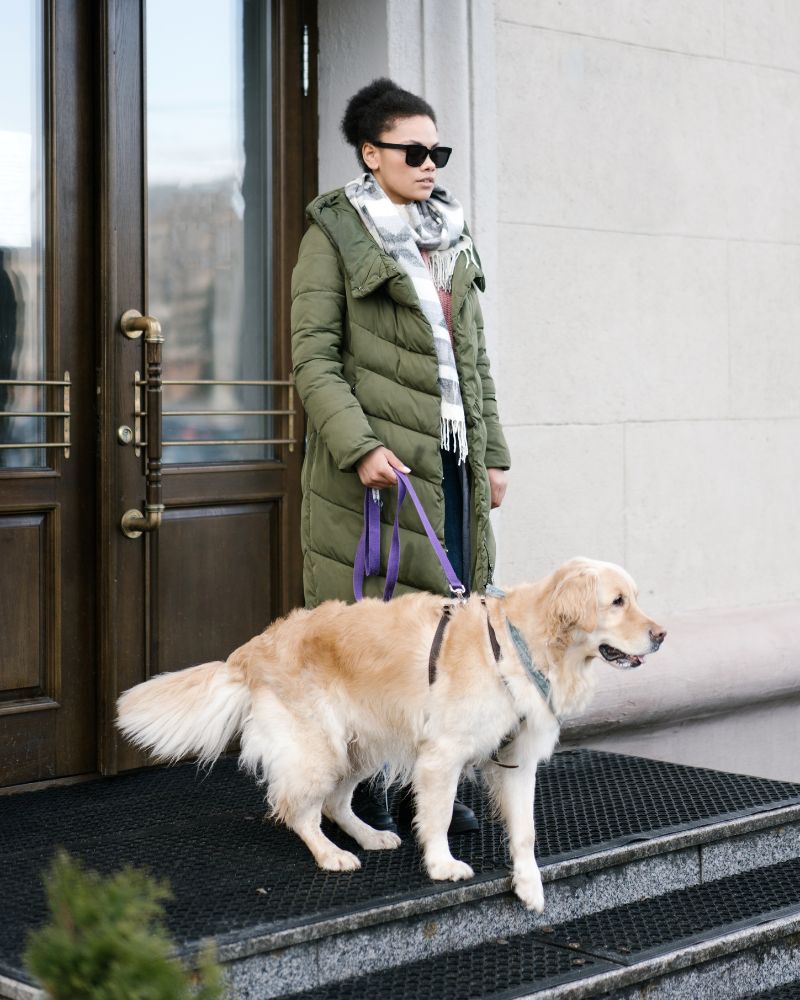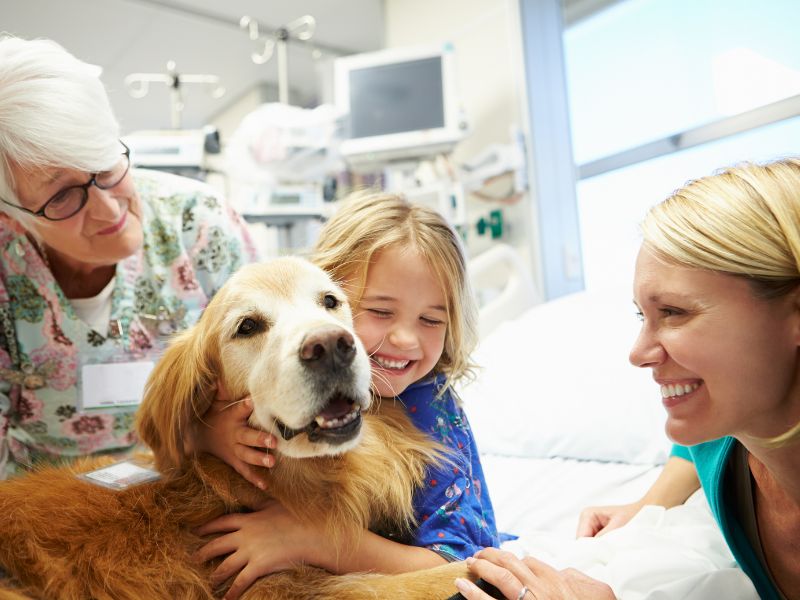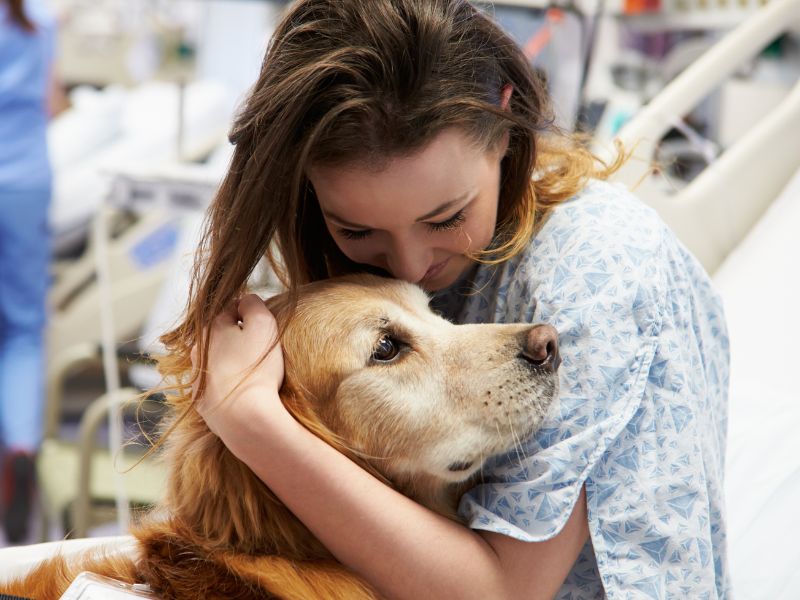Golden retrievers are a beloved breed of dog known for their friendly and loyal nature. They are often trained as therapy dogs due to their gentle temperament and desire to please their owners. Therapy dogs provide comfort and emotional support to people in hospitals, nursing homes, and other settings.
Golden retriever therapy dogs are particularly well-suited for this role due to their intelligence and trainability. They are able to learn a wide variety of tasks and are eager to perform them for their owners. These dogs are trained to provide physical comfort, such as snuggling with patients or resting their head on a person’s lap, as well as emotional support by simply being present and offering a friendly, non-judgmental presence.
Many people find that spending time with a therapy dog can help reduce stress and anxiety, lower blood pressure, and improve overall mood. Golden retriever therapy dogs are especially effective at providing comfort to children and adults with special needs, as well as those who are recovering from illness or injury. These dogs are truly special animals that bring joy and comfort to those in need.
How To Become A Therapy Dog [Video]
Becoming a therapy dog is a rewarding experience for both the dog and their owner. Therapy dogs provide comfort and support to people in hospitals, nursing homes, schools, and other settings. If you have a golden retriever and would like to train them to become a therapy dog, here are some steps you can take.
First, make sure your dog has basic obedience training. This includes commands like sit, stay, come, and heel. Your dog should also be comfortable walking on a leash and interacting with other dogs and people.
Next, consider enrolling your dog in a therapy dog training program. These programs teach dogs how to interact with people in various settings and prepare them for the certification process.
Once your dog has completed the training program, they will need to pass a certification test. The certification test evaluates the dog’s behavior and temperament in different situations. The test may include tasks like walking on a leash, interacting with strangers, and staying calm in noisy environments.
It’s important to note that not all dogs are suited for therapy work. Dogs that are aggressive, anxious, or easily frightened may not be a good fit for this type of work. It’s important to assess your dog’s temperament and behavior before beginning the training process.
In conclusion, becoming a therapy dog requires dedication and hard work from both the dog and their owner. With proper training and certification, your golden retriever can bring comfort and joy to people in need.
Carefree Goldens
Enzo, Cooper, Tazio, and Porsche are the four golden retrievers behind “The Carefree Goldens.” Enzo and Cooper are registered therapy dogs and actively work at multiple facilities. They bring joy to humans both near and far, young and old. Tazio is a therapy dog in training, while Porsche is still a playful pup.
Enzo and Cooper have been trained to provide emotional support and comfort to people in hospitals, nursing homes, and other settings. They are also trained to work with children with autism and other special needs. Enzo and Cooper have received several certifications and awards, including the CGC, CD, TKE, VHMA, THD, RN, and 2K9.
Tazio is following in the footsteps of Enzo and Cooper and is currently undergoing training to become a therapy dog. He is only five months old, but he is already showing great potential. Tazio loves to play and cuddle, and he is always eager to learn new things.
Porsche is the newest addition to the Carefree Goldens family. She is still a playful pup, but she is already showing signs of becoming a great therapy dog. Porsche loves to play fetch and go for walks, and she is always eager to meet new people.
The Carefree Goldens are not only great therapy dogs, but they are also great ambassadors for the golden retriever breed. They are friendly, loyal, and intelligent dogs that love to be around people. The Carefree Goldens have a large following on social media, and they use their platform to spread awareness about the benefits of therapy dogs and the importance of animal welfare.
What Do Therapy Dogs Actually Do?
Therapy dogs are trained to provide comfort, support, and affection to people in hospitals, nursing homes, schools, and other settings. These dogs can help reduce stress, anxiety, and depression, and improve overall well-being. Here are some of the things that therapy dogs actually do:
- Provide emotional support: Therapy dogs are trained to sense when someone is feeling sad, anxious, or upset, and they will often nuzzle or cuddle with that person to provide comfort and support. They can also help reduce feelings of loneliness and isolation, especially for people who are hospitalized or living in care facilities.
- Assist with physical therapy: Some therapy dogs are trained to help people with physical disabilities or injuries. For example, they may assist with range-of-motion exercises, help someone walk or stand, or even retrieve items for someone who is unable to do so themselves.
- Help with reading: Many therapy dogs are used in schools and libraries to help children improve their reading skills. Kids who are struggling with reading may feel self-conscious or embarrassed, but reading to a friendly dog can help them feel more relaxed and confident.
- Provide companionship: Therapy dogs are often used in nursing homes and assisted living facilities to provide companionship to residents. These dogs can help reduce feelings of boredom and depression, and they can also encourage social interaction among residents.
Overall, therapy dogs play an important role in improving the quality of life for many people. They are trained to provide comfort, support, and affection, and they can help reduce stress, anxiety, and depression. If you are interested in becoming a therapy dog handler, it is important to work with a reputable organization and ensure that your dog is properly trained and certified.
What Makes A Good Therapy Dog?
Therapy dogs are trained to provide comfort and emotional support to people in need. They are often used in hospitals, nursing homes, schools, and other settings to help reduce stress and anxiety. Golden Retrievers are a popular breed for therapy work due to their friendly and gentle nature. But what makes a good therapy dog?
First and foremost, a good therapy dog is well-behaved and obedient. They should be able to follow basic commands and be comfortable around people of all ages and backgrounds. They should also be calm and patient, able to handle unexpected noises, movements, and interactions.
Another important trait of a good therapy dog is their temperament. They should be friendly, affectionate, and enjoy being around people. They should not be aggressive or easily frightened. It’s important to remember that not all dogs are suited for therapy work, and it’s up to the owner to determine if their dog has the right temperament for the job.
Training is also a key factor in what makes a good therapy dog. Dogs need to be trained to interact with people in a positive and appropriate manner. They should be trained to walk on a leash, sit, stay, and come when called. They should also be trained to tolerate being petted, hugged, and handled by strangers.
In addition to basic obedience training, therapy dogs need to be trained to handle different environments and situations. They should be comfortable in crowded and noisy places, as well as around medical equipment and other distractions. They should also be trained to handle unexpected situations, such as sudden movements or loud noises.
Overall, a good therapy dog is one that is well-behaved, friendly, and well-trained. Golden Retrievers are a great breed for therapy work due to their natural temperament and gentle nature. However, it’s important to remember that not all dogs are suited for therapy work, and owners should carefully consider their dog’s temperament and training before pursuing therapy work.
How Does Your Dog Become A Therapy Dog?
Becoming a therapy dog is a great way for your Golden Retriever to help people in need. Here are the steps you need to take to get your furry friend certified as a therapy dog:
Step 1: Basic Training
Before your dog can become a therapy dog, they need to have basic obedience training. This includes commands such as “sit,” “stay,” “come,” and “heel.” They should also be well-behaved and under control in public places. The American Kennel Club’s Canine Good Citizen (CGC) test is a great way to ensure your dog has the necessary skills for therapy work.
Step 2: Specific Training
After your dog has passed the CGC test, they will need to undergo specific training for therapy work. This includes learning how to interact with different types of people, such as children and the elderly. They will also need to be comfortable in a variety of environments, such as hospitals and nursing homes.
Step 3: Certification
Once your dog has completed their training, they will need to be certified as a therapy dog. This involves passing a test administered by a therapy dog organization. Some popular organizations include Therapy Dogs International and Pet Partners. Certification requirements vary by organization, but typically include a health screening and proof of vaccinations.
It’s important to note that not all dogs are suited for therapy work. Your dog should be friendly, calm, and enjoy being around people. If your dog shows signs of anxiety or aggression, therapy work may not be the best fit for them.
Training
Training is an essential part of preparing a golden retriever to become a therapy dog. The training process involves teaching the dog basic obedience commands, socialization, and handling. Here are some tips for training a golden retriever to be a therapy dog:
- Obedience Method: This method involves teaching the dog basic commands like sit, stay, come, and heel. It also involves teaching the dog to walk calmly on a leash and to be comfortable around other dogs and distractions.
- Socialization Method: This method involves exposing the dog to different people, places, and situations to help them become comfortable and confident in unfamiliar environments.
- Handling Method: This method involves teaching the dog to be comfortable with being touched and handled by strangers, as therapy dogs will often be petted and hugged by people they don’t know.
It’s important to start training early, as puppies are more receptive to learning and socialization. Training should be consistent and positive, using rewards and praise to reinforce good behavior.
Additionally, certification is often required for therapy dogs, and training programs are available to help prepare dogs for certification exams. These programs can provide additional training and support to ensure that the dog is fully prepared for their role as a therapy dog.
How You Can Help
If you are interested in helping others with your golden retriever, becoming a therapy dog team might be the perfect fit for you. There are several ways you can get involved in therapy work with your dog, and it doesn’t require any special skills or training.
First, you can volunteer with a therapy dog organization in your community. Organizations like Therapy Dogs International and Pet Partners provide training and certification for dogs and their handlers to become therapy teams. Once certified, you and your dog can visit hospitals, nursing homes, schools, and other facilities to provide comfort and companionship to those in need.
Another way to get involved is by participating in reading programs with your dog. Many libraries and schools have programs where children can read to therapy dogs to improve their reading skills and confidence. This is a great way to help both children and your community.
Finally, you can also consider starting your own therapy dog program. This could involve partnering with a local organization or facility to provide regular visits with your dog. It may take some effort to get started, but the impact you can have on others is immeasurable.
No matter how you choose to get involved, remember that therapy work is a team effort between you and your dog. It requires patience, dedication, and a willingness to help others. But with the right attitude and training, you and your golden retriever can make a positive difference in the lives of those around you.
Resources
If you are interested in training your Golden Retriever to become a therapy dog, there are many resources available to help you get started. Here are a few options:
Therapy Dog Organizations
There are several organizations that specialize in training and certifying therapy dogs. These organizations can provide guidance on the training process and help connect you with volunteer opportunities in your community. Some popular organizations include:
- Therapy Dogs International
- Pet Partners
- Alliance of Therapy Dogs
Training Programs
If you prefer a more structured approach to training, there are also many training programs available specifically for therapy dogs. These programs typically cover obedience training, socialization, and specific skills needed for therapy work. Some popular programs include:
- Canine Good Citizen Program
- AKC Therapy Dog Program
- Bright & Beautiful Therapy Dogs, Inc.
Books and Online Resources
For those who prefer to learn on their own, there are many books and online resources available on training therapy dogs. Some popular options include:
- “Therapy Dogs: Training Your Dog to Reach Others” by Kathy Diamond Davis
- “The Power of Positive Dog Training” by Pat Miller
- The American Kennel Club’s website, which offers a variety of articles and resources on training therapy dogs.
No matter which resources you choose, remember that training a therapy dog is a significant commitment, both in terms of time and effort. But for those who are willing to put in the work, the rewards can be immeasurable.
Conclusion
Golden retriever therapy dogs are specially trained animals that provide emotional support and comfort to individuals in various settings such as hospitals, nursing homes, schools, and rehabilitation centers. These dogs have a calm and gentle temperament and are obedient, making them ideal for this role.
Therapy dogs play an important role in providing companionship, affection, and emotional support to those who are experiencing physical or mental health challenges. They can help reduce stress and anxiety, lower blood pressure, and improve overall well-being.
Golden retrievers, in particular, are known for their friendly and affectionate nature. They have been bred for centuries to be gentle and friendly companions, making them perfect for the role of therapy dogs. Their soft fur and wagging tails can bring a smile to anyone’s face.
If you or someone you know is in need of emotional support, consider the benefits of a golden retriever therapy dog. These furry friends can make a big difference in someone’s life and provide comfort and love when it is needed most.














